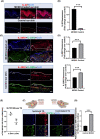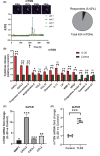IL-20 promotes cutaneous inflammation and peripheral itch sensation in atopic dermatitis
- PMID: 35486004
- PMCID: PMC9321592
- DOI: 10.1096/fj.202101800R
IL-20 promotes cutaneous inflammation and peripheral itch sensation in atopic dermatitis
Abstract
Atopic dermatitis (AD) is a chronic skin disease, which is associated with intense itch, skin barrier dysfunction and eczematous lesions. Aberrant IL-20 expression has been implicated in numerous inflammatory diseases, including psoriasis. However, the role of IL-20 in AD remains unknown. Here, RNA-seq, Q-PCR, and immunocytochemistry were utilized to examine disease-driven changes of IL-20 and its cognate receptor subunits in skin from healthy human subjects, AD patients and murine AD-models. Calcium imaging, knockdown and cytokine array were used to investigate IL-20-evoked responses in keratinocytes and sensory neurons. The murine cheek model and behavioral scoring were employed to evaluate IL-20-elicited sensations in vivo. We found that transcripts and protein of IL-20 were upregulated in skin from human AD and murine AD-like models. Topical MC903 treatment in mice ear enhanced IL-20R1 expression in the trigeminal sensory ganglia, suggesting a lesion-associated and epidermal-driven mechanism for sensitization of sensory IL-20 signaling. IL-20 triggered calcium influx in both keratinocytes and sensory neurons, and promoted their AD-related molecule release and transcription of itch-related genes. In sensory neurons, IL-20 application increased TLR2 transcripts, implicating a link between innate immune response and IL-20. In a murine cheek model of acute itch, intradermal injection IL-20 and IL-13 elicited significant itch-like behavior, though only when co-injected. Our findings provide novel insights into IL-20 function in peripheral (skin-derived) itch and clinically relevant intercellular neuron-epidermal communication, highlighting a role of IL-20 signaling in the pathophysiology of AD, thus forming a new basis for the development of a novel antipruritic strategy via interrupting IL-20 epidermal pathways.
Keywords: IL-13; IL-13Rα1; IL-13Rα2; IL-20; IL-20R1; IL-20R2; atopic dermatitis; cytokine; toll-like receptor.
© 2022 Federation of American Societies for Experimental Biology.
Figures






Similar articles
-
Innate immune regulates cutaneous sensory IL-13 receptor alpha 2 to promote atopic dermatitis.Brain Behav Immun. 2021 Nov;98:28-39. doi: 10.1016/j.bbi.2021.08.211. Epub 2021 Aug 13. Brain Behav Immun. 2021. PMID: 34391816
-
New mechanism underlying IL-31-induced atopic dermatitis.J Allergy Clin Immunol. 2018 May;141(5):1677-1689.e8. doi: 10.1016/j.jaci.2017.12.1002. Epub 2018 Feb 7. J Allergy Clin Immunol. 2018. PMID: 29427643
-
Neuronal BST2: A Pruritic Mediator alongside Protease-Activated Receptor 2 in the IL-27-Driven Itch Pathway.J Invest Dermatol. 2024 Aug;144(8):1829-1842.e4. doi: 10.1016/j.jid.2024.01.025. Epub 2024 Feb 13. J Invest Dermatol. 2024. PMID: 38360199
-
Th2 Modulation of Transient Receptor Potential Channels: An Unmet Therapeutic Intervention for Atopic Dermatitis.Front Immunol. 2021 Jun 30;12:696784. doi: 10.3389/fimmu.2021.696784. eCollection 2021. Front Immunol. 2021. PMID: 34276687 Free PMC article. Review.
-
Mediators of Chronic Pruritus in Atopic Dermatitis: Getting the Itch Out?Clin Rev Allergy Immunol. 2016 Dec;51(3):263-292. doi: 10.1007/s12016-015-8488-5. Clin Rev Allergy Immunol. 2016. PMID: 25931325 Review.
Cited by
-
In vitro models for investigating itch.Front Mol Neurosci. 2022 Oct 26;15:984126. doi: 10.3389/fnmol.2022.984126. eCollection 2022. Front Mol Neurosci. 2022. PMID: 36385768 Free PMC article. Review.
-
Systemic Inflammatory Proteomic Biomarkers in Atopic Dermatitis: Exploring Potential Indicators for Disease Severity.J Korean Med Sci. 2024 Aug 12;39(31):e223. doi: 10.3346/jkms.2024.39.e223. J Korean Med Sci. 2024. PMID: 39137810 Free PMC article.
-
5-HT7 antagonists confer analgesia via suppression of neurotrophin overproduction in submucosal nerves of mouse models with visceral hypersensitivity.J Physiol. 2025 Sep;603(17):4723-4745. doi: 10.1113/JP286444. Epub 2025 Aug 4. J Physiol. 2025. PMID: 40757652 Free PMC article.
-
IL-20RA is Associated with the Risk of Diabetic Microangiopathy: A Bidirectional Mendelian Randomization Analysis and Clinical Validation.Diabetes Metab Syndr Obes. 2024 Dec 18;17:4803-4816. doi: 10.2147/DMSO.S480366. eCollection 2024. Diabetes Metab Syndr Obes. 2024. PMID: 39712242 Free PMC article.
-
Allergen sensitization stratifies IL-31 production by memory T cells in atopic dermatitis patients.Front Immunol. 2023 Mar 13;14:1124018. doi: 10.3389/fimmu.2023.1124018. eCollection 2023. Front Immunol. 2023. PMID: 36993985 Free PMC article.
References
-
- Langan SM, Irvine AD, Weidinger S. Atopic dermatitis. Lancet. 2020;396:345‐360. - PubMed
-
- Bieber T. Atopic dermatitis. N Engl J Med. 2008;358:1483‐1494. - PubMed
-
- Weidinger S, Beck LA, Bieber T, Kabashima K, Irvine AD. Atopic dermatitis. Nat Rev Dis Primers. 2018;4:1. - PubMed
-
- Yosipovitch G. Introduction for understanding and treating itch. Dermatol Ther. 2013;26:83. - PubMed
-
- Ikoma A. [Therapeutic agents of today and the future for atopic dermatitis]. Nihon Yakurigaku Zasshi. 2006;128:411‐415. - PubMed
Publication types
MeSH terms
Substances
LinkOut - more resources
Full Text Sources
Molecular Biology Databases
Research Materials

